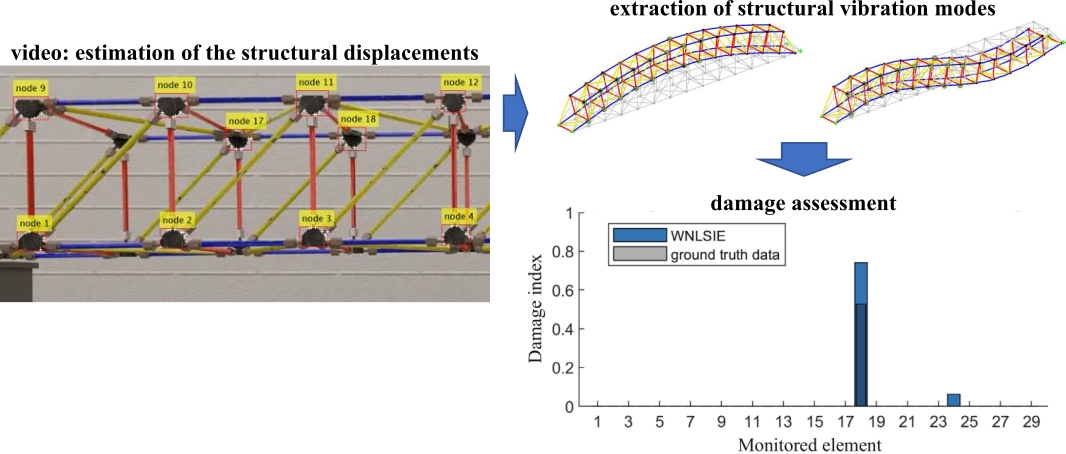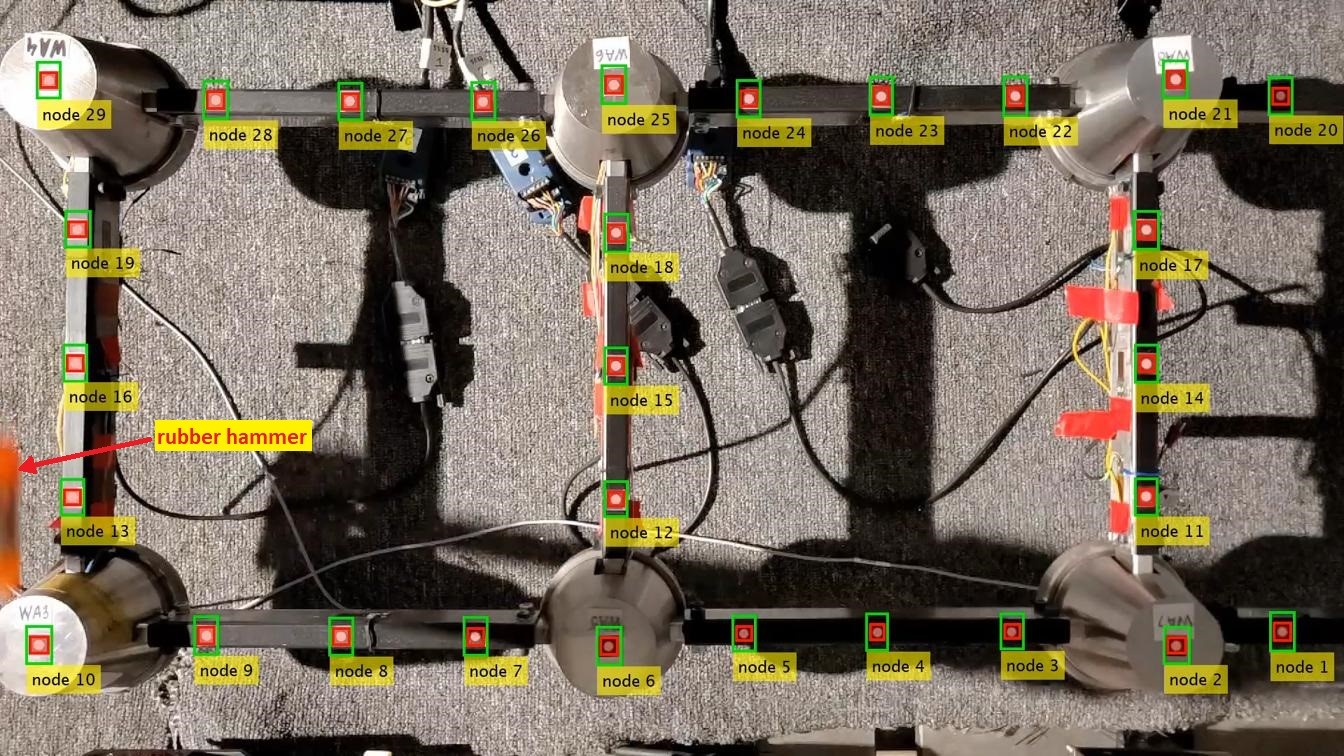We invite you to read a series of three works on the identification of the stiffness of mechanical structures.
- Ostrowski M., Błachowski B., Wójcik B., Żarski M., Tauzowski P., Jankowski Ł.
A framework for computer vision-based health monitoring of a truss structure subjected to unknown excitations, - Ostrowski M., Błachowski B., Mikułowski G., Jankowski Ł.
Influence of Noise in Computer-Vision-Based Measurements on Parameter Identification in Structural Dynamics, - Ostrowski M., Mikułkowski G., Błachowski B., Jankowski Ł.
Experimental assessment of Bayesian and mode matching approaches for parametric identification of bolted connections,
"This research can be applied in monitoring of a civil infrastructure condition as well as model updating so that it more accurately reflects the behaviour of a real structure, for example in order to perform a reliable computer simulation" - explains Mariusz Ostrowski - the first author of the presented publications, working at the Department of Intelligent Technologies IPPT PAN.
He adds that "updating of the structural model involves changing its parameters so that it reflects the behaviour of its real counterpart as closely as possible. Regarding the application for monitoring of the civil infrastructure condition, stiffness of various structural components usually are the modified parameters. When a damage occurs in the monitored structure characterized by a change in the stiffness of the element transmitting loads, the natural frequencies and modes shapes change. By identifying the natural frequencies and mode shapes of the damaged structure, we can use them further in the model updating procedure. Having a properly prepared computer model, its natural frequencies and vibration modes will be very close to those obtained from the damaged structure when we modify the stiffness of the elements in this model corresponding to elements damaged in the monitored system. This makes it possible not only to detect and locate the damage (in elements with changed stiffness), but also to estimate its progress (the degree of stiffness reduction). However, the problem is measurement and modeling errors, which affect the accuracy of estimation of the stiffness parameters. In addition, systems monitoring the infrastructure condition are expensive and difficult to implement due to the large number of sensors, their wiring, and in the case of a wireless network, there are problems with their synchronization. Thus, computer vision-based measurement methods with the aid of digital cameras have recently been intensively developed. Image processing allows us to estimate displacements at multiple points in the structure. It significantly reduces the costs. The influence of measurement errors and hardware limitations on the accuracy of stiffness parameter estimation is the subject of this study."
The first of the three papers, entitled „A framework for computer vision-based health monitoring of a truss structure subjected to unknown excitations” was published in the journal Earthquake Engineering and Engineering Vibration (Springer). The article was written at the invitation of the journal's editors due to the fact that the first results of the research allowed for the sixth place in the international competition IC-SHM, 2021. The published article concerns the selection of an appropriate method of model updating to the natural frequencies and mode shapes of truss structure estimated with the use of computer vision. A video showing the vibrating structure was used for the analysis. It should be noted that computer vision is characterized by large measurement errors for small-amplitude and high-frequency displacements. It turned out that the use of model updating method based on the calculation of the sensitivity matrix of modal parameters to changes in the stiffness of individual elements of the structure, limiting the stiffness increases only to negative values (that reflects the damage) gives the best results among the tested methods. This method, previously proposed by Bartłomiej Błachowski, PhD, DSc, after modifications, allows for the detection, localization and estimation of the level of damage to truss structures in the presence of large measurement errors (standard deviation of error equal to up to 50% of the root-mean-square value of displacements). In addition, the selected method shows very small tendency to erroneously detect the damage in undamaged elements. In this paper, a methodology for monitoring civil infrastructure condition, whose vibration is excited by unknown (unmeasured) excitations, using computer vision is proposed (see figure below).

Figure 1. Schematic diagram of the proposed methodology for civil infrastructure condition assessment
The second paper in the series also discusses the model updating with aid of the computer vision. It shows the influence of measurement errors and hardware limitations of a high-speed smartphone camera on the model updating process and the degree of uncertainty of the estimated structural stiffness. A high-speed camera recorded the vibrations of a laboratory demonstrator of a frame structure containing bolted connections. The stiffness of these bolted connections was estimated by updating the model of the frame. The frame with the traced markers is shown in Figure 2. For comparison, accelerometers and laser displacement sensors were also used in the measurements. The paper “Influence of Noise in Computer-Vision-Based Measurements on Parameter Identification in Structural Dynamics” was written at the invitation of the editors of the journal Sensors (MDPI) in a special issue entitled “Intelligent Sensing Technologies in Structural Health Monitoring”. The study has shown that measurement errors and hardware limitations of the smartphone camera do not significantly affect the variance of the estimated vibration modes (mode shapes and natural frequencies) and the stiffness of the bolted connections, but they clearly increase the bias (systematic) error. The accuracy of stiffness parameter estimation can be improved by reducing the number of estimated parameters in the model. The research shows that the smartphone only allows for initial updating of the model, or updating in applications where high precision is not required.

Figure 2. Example of the video frame registered by the smartphone camera accompanied by the templates that are to be tracked during the video processing; impact excitation by a rubber hammer [source: Sensors. 2023; 23(1):291]
The third paper entitled “Experimental assessment of Bayesian and mode matching approaches for parametric identification of bolted connections” published in the prestigious journal Mechanical Systems and Signal Processing (Elsevier) compares two widely accepted methods for updating models of mechanical structures: (1) a method based on the sensitivity of modal parameters to changes in the stiffness, and (2) a Bayesian approach proposed by Prof. Yuen. The comparison concerned the estimation of the stiffness of the bolted connections. The first method requires the calculation of the error between the vibration modes identified experimentally and the corresponding modes determined with the aid of the computer model. To do this, finding matching pairs of experimental and numerical (obtained from computer model) vibration modes is required. This process can be significantly hindered when we have a small number of sensors (it is not possible to compare the mode shapes or calculate their correlation coefficients properly). In addition, the computer model changes during its updating, and thus also the numerically determined vibration modes and their order, which makes it even more difficult to pair the corresponding vibration modes. The method proposed by Prof. Yuen is devoid of these drawbacks. However, the research has shown that despite the lack of the need for matching the pairs of numerical and experimental vibration modes, Prof. Yuen's approach should not be recommended for identifying the stiffness of the bolted connections. It is due to problems with the convergence of this method (a tremendous computational burden is required to find the result). In addition, numerical problems make it impossible to reliably estimate the variance of stiffness parameters. These problems do not occur using the first method.















